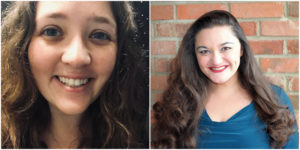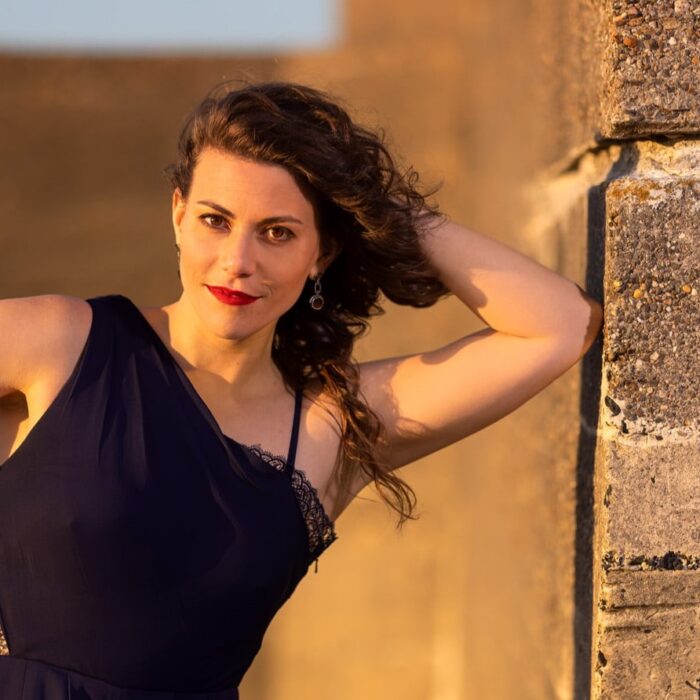
Q & A: Composer Sarah Van Sciver & Librettist Kirsten C. Kunkle on Their New Opera ‘Girondines’
By Chris RuelOn Oct. 21, 2022, Wilmington Concert Opera will present a new opera, “Girondines,” composed by Sarah Van Sciver, to a libretto by WCO’s Co-founder and Artistic Director, Kirsten C. Kunkle. Van Sciver will music direct and perform as the presentation’s pianist.
“Girondines” is a story of a society of six women, all living during the time of the French Revolution. Together, they are friends, intellectuals, feminists, revolutionaries, and even considered radicals. No one knows they have an association. Through them, essential works are written, and major events happen–always under the surface. Three of the women were killed while the others continued with their lives.
OperaWire posed questions to both Van Scriver and Kunkle about the project’s genesis, its musical language, and the fascinating characters that inhabit “Girondines.”
OW: What was the genesis of the project?
Sarah Van Sciver: Kirsten and I were introduced by our mutual friend Brenna Geffers back in 2016 when we were working on “Shadow House,” an original production for which Brenna was librettist and director. “Shadow House” was an immersive opera: in a ‘haunted’ historical building, actors portrayed ghosts of real people who lived in the same house over time, and audience visitors made their way through each chamber, engulfed in interconnected ghosts’ histories conveyed with opera soloist and group performances.
Before I began composing music for “Shadow House,” Brenna let me know that Kirsten would portray Edith, and when I heard recordings of Kirsten’s voice, I was instantly enthralled by her superb instrument.
After writing music for Kirsten once, I was eager to work with her again and leaped at the opportunity. Kirsten prompted me for libretto material proposals featuring real or imagined women, preferably in storylines that would pass the Bechdel test. I was delighted that our exchange catalyzed Kirsten’s Internet spelunking and brilliant choice of Charlotte Corday flanked by five more French Revolutionary historical women figures for our ensemble. Kirsten’s libretto was my introduction to most of the stories we are telling.
I greatly admire the work of Kirsten and her Wilmington Concert Opera Co-founder Marisa Robinson. As a passionate advocate for amplifying diversity, inclusivity, access, and equity in the arts, I am proud to partner with WCO for the “Girondines” premiere due to its meaningful mission.
Kirsten C. Kunkle: As Sarah stated, this project began in the most 21st-century way imaginable. I had known Sarah from previously singing her music but had never met her in person. During the pandemic, I wrote another libretto and posted about it online. She casually mentioned to me that should I write another libretto, she would like to set it to music. I responded to her directly and said that we should go ahead and write an opera. It was that simple.
I asked her to send me a list of topics that she found interesting for an operatic project. She sent me many topics, and ultimately, I chose none of them. However, researching those topics sent me down a rabbit hole of the Internet, and I discovered numerous influential and important women who lived, created, and struggled during the Reign of Terror during the French Revolution.
I was immediately struck by what amazing storytelling could happen by taking their true stories and weaving them together with the added fictional element of making them friends and confidants. Therein lies the heart and soul of “Girondines.” My goal was to humanize these historical figures and make them resonate with a modern audience while telling their true stories.
OW: How would you describe the musical language of “Girondines”?
SVS: The music of “Girondines” features contemporary and classical elements, drawing inspiration from opera, theater, and cinema music traditions as well as pop, experimental, folk, jazz, and rock vocabularies. My artmaking is centered on using music and sound to scaffold storytelling–not only writing music for opera, theater, and musicals but also a great deal of songwriting, film scoring, and crafting sound and music for other narrative contexts, with or without lyrics.
The musical language of this opera reflects my love for and fascination with many genres and forms. Kirsten’s libretto prompted me to craft distinct motifs for each of our six characters and to feature certain tonalities, techniques, and musical grammar. We have consonance and dissonance, aria and recitative, hockets and hooky melodies, syncopation, and sound art. Kirsten gave me gorgeous words and clear prompts, as well as trust, freedom, and encouragement to overlay my own ideas, syncopation, and colors.
For opera buffs, this story presentation definitely has more in common with ‘tragédie en musique’ or ‘opera seria’ (serious opera in the French or Italian traditions) than ‘opera comique’ or ‘opera buffa; (comic opera in the French or Italian traditions). The ‘tragédie en musique’ tradition inspired me to write several of this opera’s pieces with classical and contemporary dance forms (minuet and tango, among others) and to incorporate choral stylings in ensemble sections. Unlike many French operas, our story is told in two acts instead of five (but maybe someday Kirsten and I will expand and develop this to have five acts, after all?)
OW: Were there challenges you faced while composing?
SVS: Throughout this project, Kirsten and I have been contending with significant shifts in our lives–big moves, new babies, and career changes. My son was born in the middle of composing this opera, and adding motherhood into the mix meant that pacing the project could be challenging at times. I have always been a night owl and a high-functioning insomniac, but my nighttime bandwidth certainly took a hit when I was pregnant. Adapting to motherhood has ultimately helped me to become even more focused and efficient, to take advantage of breaks to return to my material with fresh eyes, and to even more deeply appreciate every friend and family member who helps facilitate time and space for my artistic practice.
Originally, the opera was conceived to be written for six voices plus piano, harp, and electronics. My initial approach had the harp taking on many contrasting textures, producing some sound effect accents to add to the electronics’ soundscapes, and using many extended techniques for bursts of color. As a vocalist, pianist, harpist, sound artist, and sometimes ukulele player, guitarist, and percussionist myself, it was exciting to develop orchestration featuring so many of my fluent instruments.
I worked for about six months to craft nuanced accompaniment, with extra detail work in the harp part. A late-in-the-game pivot to replace harp in the WCO premiere production with two string players resulted in my only having about six days(!) during which to re-orchestrate. Adapting the original piano-harp accompaniment into piano-violin-cello was a tough task because my turnaround time was a tiny fraction of what it had been the first time around, and there are significant differences in tunings, tessituras, and extended technique options for the harp vs. violin and cello.
However, reworking accompaniment material also provided opportunities to support singers’ parts in new ways. Wherever we mount the next production of “Girondines,” it will be interesting to experiment with harp with or without strings alongside piano in the accompaniment and to consider the addition of other instruments.
Crafting soundscapes was a delicate balance. We decided to use electronics for all pieces of the opera, which take place in a specific setting. (The opening, finale, and entr’acte are performed without soundscapes, but every other piece has sound elements to orient the audience in our characters’ locations – jail cells, guillotines, gardens, estates, and so on.)
Kirsten and I wanted to collage sound design elements and musical drones to connote moods and spaces without crowding singers’ melodies or instruments’ harmonies and textures. Kirsten was a huge help in fine-tuning the soundscapes to avoid obscuring singers’ or instrumentalists’ textures.
OW: Describe your creative process for the collaboration.
SVS: I read Kirsten’s libretto repeatedly, front-to-back, back-to-front, and picked it up from multiple places part-way. I find I adapt texts best when I access them from many angles and approaches. Speaking with Kirsten about the performers with whom we would be working, I customized parts to showcase the voices of our stellar ensemble.
Using Kirsten’s exquisite text, I improvised at the harp and piano to develop thematic and textural ideas to epitomize our characters, story, and setting. Then I worked piece by piece (I typically start with solo arias first to focus on each singer individually and then work my way out to ensemble sections) to compose melodies, countermelodies, and then piano and harp accompaniment. Each one of our Girondine women has their own musical motif, so I wove these themes and variations on them throughout the opera. Charlotte Corday, whom Kirsten portrays, is a catalyst for all our other historical figures’ fates, so Charlotte’s theme and its variations are threaded prominently throughout the tapestry of this opera.
Composing in this idiom is a balancing act of blending new and recurring elements so that opera pieces thrive together and individually. In crafting this opera, we gave every performer the opportunity to contribute feedback before I finalized composition. It was exciting to have performers involved in the inception phase and extremely exciting to hear the music sung by the exceptional group of performers with whom we’re working.
Creative collaboration is key, as stories become richer when many voices join in the telling of them. Love of language and a passion for singing make me strive to tell great stories with music that speaks to everyone. My style is contemporary and commercial, drawing upon media and traditions past and present. It is a thrill to produce new works that can resonate with audiences for years to come, using music to reinforce the timelessness of compelling stories.
KCK: Generally, when I get excited about a project, I tend to dive right in. For this particular libretto, I needed to do quite a bit of research. I was not familiar with five of the six characters prior to deciding to write this work, so I had to learn their histories, but more importantly, I needed to know why they did the work that they chose to do. I needed to understand why they would be willing to sacrifice their lives for their art, science, or words. I needed to humanize a murderer in an honest and meaningful way. I had to tell their stories, but from their point of view. So, I learned everything I could about these women that I have named our Girondines.
I tried to bring out the personalities that were historically documented, but also combined that with what I interpreted from their work. I also had certain people in mind for most roles for the premiere while I was writing the text. I was in the remarkable position of knowing that this work would be premiered by my own opera company, Wilmington Concert Opera, where I am Co-Founder and Artistic Director. Because of that, I could use elements of the personalities of the singers I hoped would accept the roles in those characters. I was fortunate that they all agreed to sing for the premiere.
I sketched out a basic outline of the shape of the opera and decided an order of how everything needed to happen based on history. Then I started writing scenes. I began with “September Massacre,” which is the aria that Charlotte sings while contemplating murdering Marat. I sent it to Sarah to see what she thought of it, and she loved it. From there, I dove in and wrote scene by scene, not in order, but by what inspired me most at that moment. Once it was finished, I edited and cleaned everything up. Sarah, remarkably, didn’t ask for any changes, except to add Charlotte to the “Reign of Terror” number. We went back and forth on it, and she ended up adding her to the very end in a more subdued way than she initially planned. That was the only change she requested from me, and from there, I handed the libretto over to her to make musical magic.
OW: “Girondines” is a feminist opera. What does that mean?
SVS: Pervasive problems persist throughout the art world in the form of gender and identity discrimination, sexism, ageism, racism, bias, the ‘maternal wall,’ lack of access in the training pipeline, disparities in role and composer distribution … I am proud to be part of a feminist opera and a production team that rejects these norms and rewrites the script to amplify unsung voices, advocating for systemic change. Gender equality is a necessity about which I am very passionate, so I am glad this opera abandons antiquated archetypes to better reflect diversity and complexity of the world around us. I hope the creation of this opera inspires more composers to create new works to shake up the supply and demand for feminist operas. I would love for our production to represent a massive expansion of the trends, successes, and opportunities involving progressive and feminist new music works.
KCK: Opera is an art form that often gives a role or two to women and features many men. There are exceptions, of course, but often the women-centric operas are about nuns. There are so many options for women in real life besides the convent, as we all know. However, opera is often stuck in the mentality that only famous operas will draw a crowd, so we rarely see the growth that is needed to reflect our times, beyond an occasional new music work on a season of multiple operas. I wanted to give women opera singers a chance to be heard, both literally and figuratively. A chamber opera that features six women is perfect (and necessary) for most university-level programs. I believe that “Girondines” is the kind of repertoire that collegiate opera directors, as well as opera companies, should be considering.
With the creation of “Girondines,” six women will have viable roles. (In the world premiere there are twelve women, because it is double cast at Wilmington Concert Opera). Each of those roles feature an aria that can be excerpted for auditions or concerts. (The role of Pierrette has an excerpt-able solo in a trio, but the rest are all arias). This is specifically meant to not only develop the characters within the opera as a whole, but give women singers beautiful, accessible, and exciting 21st century American arias for auditions.
I specifically want to give women the same opportunities as men in opera – and that means creating visceral, interesting, and satisfactory roles. Creating this work also means that we are changing what feminism in opera means to the audience. They will get true stories about women that focuses on their relationships with one another and their own personal goals and desires. That does not preclude the importance of being a wife or mother in a woman’s life, any more than being a husband or father would for a man. The goal is to change the perspective to be more inclusive of everything that being a woman entails.
Wilmington Concert Opera’s first opera was “Suor Angelica,” specifically because we wanted to feature women. Producing “Girondines” feels like we have come full circle, while still going back to our roots, in the most positive of ways.
OW: Why did you use the French Revolutionary period as the setting?
KCK: When researching topics for this libretto, the world was my proverbial oyster. Sarah was very open to composing on many topics, but at the heart of what we both wanted to do was to create something that would feature women and women’s stories.
I kept being drawn to the historical figure of Charlotte Corday. Specifically, I was fascinated at what would be so compelling to a woman to murder someone in such a violent way. (Most women murders are more subtle, many using poison or other less aggressive means to commit the act). I learned that she not only murdered Marat in his own bathtub (where he received guests due to a skin condition which required him to soak often), but her plans to murder him extremely publicly had been thwarted when he did not show up as planned for an event.
I found that to be utterly fascinating. Then, I found so many other women that were also influential in arts, letters, and science during that same time period. My mind likes to create scenarios (which can be both good and bad), and I thought, “what if they all knew each other… and were friends.” That “what if” took off and gave me an entire opera to write. In truth, we do know that some of the women knew each other.
Élisabeth Louise Vigée Le Brun visited Madame de Staël in Coppet, Switzerland, and even painted her, for example. So, it was entirely plausible that these women could have known each other – or at least know of each other because they traveled in similar circles. I didn’t seek out the French Revolution.
It just happened to be the right fit with a story that I decided I wanted to tell. Incredible women exist in all places and during all times of history. It is also exceptionally timely that in many ways this is a story still being told. Women are still fighting for their rights, and perhaps always will be. I have had so many people reach out to me after reading this libretto or hearing about the project to say that it still resonates with them, despite the fact that the story happened in the 1790s.
Women in France did not get the right to vote until 1944. Roe vs. Wade was overturned this year in the US. This story is an important one to be told, because the work that most of these women did was for the betterment of people as a whole. I didn’t necessarily choose the French Revolution. It chose me. These women and their work resonated so deeply for me as a professional woman, a creator, a scholar, a mother, an entrepreneur, and all the parts of who I am.
OW: Tell us about the opera’s characters.
KCK: All the women are Girondists, some more radical than others. Those killed during the Reign of Terror include Charlotte Corday, who murders Marat in his bathtub after the September Massacres. Olympe de Gouges wrote “Declaration of the Rights of Woman and of the [Female] Citizen,” which pontificated that all women were equal to men. Madame Roland (Manon) hates Robespierre, Danton, and Marat. She had to fight off sexual assault young and later became a feminist writer who was quite prolific.
The three other Girondists featured sidestepped the blade. Élisabeth Vigée Le Brun is a famous painter under the patronage of Marie Antoinette and painted over 30 portraits of her, including the most famous ones. Through her, the group has a direct connection to the royal family and keeps abreast of their actions. Madame de Staël (Germaine) is a political theorist and extremely anti-Napoleon, as well as the head of the Coppet group after the Reign of Terror. She was instrumental in the downfall of Bonaparte. Marie-Anne Pierrette Paulze Lavoisier is considered the Mother of Modern Chemistry. She lived but had to endure the death of her husband and father during the Reign of Terror. She was bankrupted but eventually regained her property and the works of her husband, thus securing his legacy after the Reign of Terror.
I think that I find a bit of myself in every character, and as a writer, I think it is inevitable that my personality will present itself in some way throughout the various characters. I decided that Charlotte Corday was the role that was most exciting for me, so I chose to premiere it.
I am fascinated that she is resolute in her mind and utterly at peace with her decision to murder because she believes she “killed one man to save 100,000.” To me, that is brilliant material for a singing actor, and thus why she resonates so deeply with me. If I were to pick a second character who has aspects of me ingrained into her character, I would pick Élisabeth Vigée Le Brun. She was a visual artist who delved deeply into a male dominated field, was prized for her fashion and aesthetic, and absolutely cherished her daughter.
She was extremely influential, but under the surface. I often see the quote that well-behaved women don’t make history. I think that they absolutely do, but in subtler ways. I feel like what I am could have an enormous impact, but I tend to do things more subtly and work change from the inside. So, Charlotte and Élisabeth represent two sides of the coin that is Kirsten C. Kunkle, and I believe that shows throughout the opera for anyone who knows me.
OW: What do you want audiences to take away from “Girondines”?
SVS: The stories we are telling and characters we are introducing are enticing and enticing. Expect drama, intrigue, a splash of comedy, and really beautiful singing and accompaniment. I hope that audiences will enjoy clever lyrics, catchy melodies that will follow them home, commanding characters, and consequential stories in “Girondines.” Kirsten and I would love for folks to leave wanting more, wanting to hear and see this production again, wanting to see “Girondines” grow and develop in new venues, expansions, and iterations. And I hope that our feminist opera propels forward necessary conversation and change pertaining to room for improvement in diversity, inclusivity, equity, and access in opera, new music, and across the arts in general.
KCK: I want people to leave “Girondines” wanting more. I want them to have a satisfying experience of storytelling through music, but I also want them craving more stories, roles, and transformative moments for women onstage. When I leave a performance in any capacity (as a singer, director, producer, etc.), I love when people say, “What’s next?”
For “Girondines,” I want people to desire more visceral roles for women, to hear more stories that they never knew, and to feel like they have grown by having learned about these amazing historical figures. I want them to experience my words and Sarah’s fantastic motives and musical composition style. I hope they leave humming the incredible melodies. I want them to leave wanting to come back and see it again and again, and to experience these stories, though tragic, and give these women the legacies they deserve. In my perfect world, “Girondines” will be a catalyst for more women’s stories to be told on the operatic stage.



